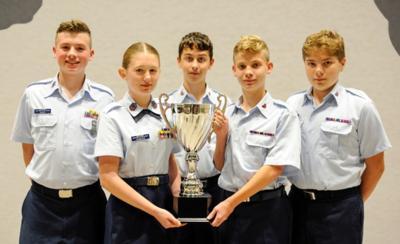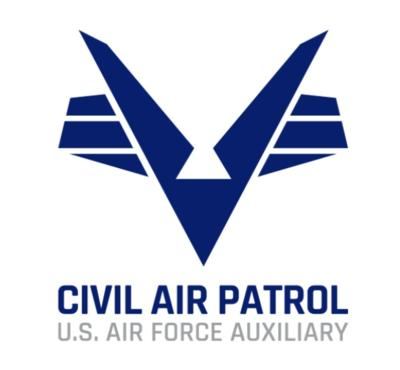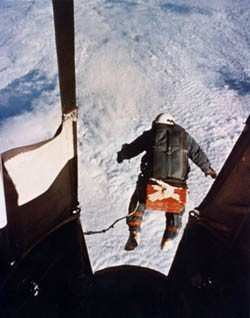Kittinger Cup Winners Announced
A five-cadet team from the Civil Air Patrol’s (CAP’s) Wisconsin Wing’s Stevens Point Composite Squadron has taken first-place honors in the third-annual Civil Air Patrol High-Altitude Balloon Challenge.

The winning team received 2023’s Kittinger Cup and an accompanying $5,000 prize for an experiment germane to cold welding in Low Earth orbit (LEO).
Cadets from the North Carolina Wing’s Raleigh Wake Composite Squadron placed second, earning a $500 prize.
Third place and a $400 prize went to the Missouri Wing’s Trail of Tears Composite Squadron team.
In all, 115 teams totaling some 950 cadets participated in the competition. Cadets worked over a span of four-months to create nearly one-thousand scientific experiments launched on a pair of weather balloons that reached burst altitudes of 100,325- and 100,318-feet, respectively.
The Stevens Point squadron team’s project received the highest cumulative score for a two-minute introductory pre-launch video, a mission patch, a complete science slide detailing the experiment, and a five-minute post-launch review video.
The winning team comprised:
- Cadet Chief Master Sergeant Lily Schaefer
- Cadet Senior Master Sergeant Barrett Dubos
- Cadet Senior Airmen Alex Albright, Greyson Krepsky, and Micah Ritter
The team was mentored by commanders: 1st Lieutenant Ryan Vechinski; team facilitator, 2nd Lieutenant Jessica Schaefer; and aerospace education officer, Lieutenant Colonel Peter Arnold.
In the aforementioned video, Senior Master Sergeant Dubos set forth: “When we started the High-Altitude Balloon Challenge, we were very interested in welding and we wondered how welding would work in low Earth orbit and beyond.”
Senior Master Sergeant Schaefer added: “We still don’t know all we want to know about cold welding and atomic bonding, and our experiment shows that. We know a lot more about how to take things to the next step, including that cold welding is best first studied here on Earth, in a lab that can replicate the vacuum of space.”

In the video, the cadets asserted their experiment would fit right in on the International Space Station (ISS).
Competition project director Captain Bob Roberts of the CAP’s South Carolina Wing remarked: “I hope that somebody from NASA sees this slide. Some of your cadets may get a phone call … I know for a fact that NASA is looking at this as well.”
The Stevens Point team plans to use the $5,000 in prize money to establish a scholarship fund by which one or more cadets may take advantage of opportunities the likes of flight and space academies.
The Air & Space Forces Association supported the national cadet STEM challenge by providing unit grants to additional category winners representing 15 wings in seven regions (the Stevens Point team hailed from the eighth region), as follows:
Hand-Drawn Mission Patches:
First Place ($200 grant): Maryland Wing, Granite Cadet Squadron.
Finalists ($150 grants): California Wing, San Francisco Cadet Squadron 86; Delaware Wing, Delaware Air National Guard Cadet Squadron; New York Wing, Ninth Suffolk Cadet Squadron.
Digitally Drawn Mission Patch Finalists:
First ($200 grant): California Wing, Santa Barbara Composite Squadron 131.
Finalists ($150 grants): Delaware Wing, Middletown Cadet Squadron; New Jersey Wing; Curtiss Wright Composite Squadron.
Pre-Launch Video:
First ($200 grant): North Carolina Wing, Raleigh-Wake Composite Squadron.
Finalists ($150 grants): Arizona Wing, Davis-Monthan Composite Squadron; New York Wing, Buffalo Composite Squadron.
Science Experiment Report:
First ($350 grant): Florida Wing, Clearwater Composite Squadron.
Finalists ($250 grant): Idaho Wing, Nampa Composite Squadron; Minnesota Wing, St. Cloud Composite Squadron.
Documentary Video:
First ($350 grant): Virginia Wing – William P. Knight Composite Squadron
Finalists ($250 grants): Florida Wing, Patrick Composite Squadron: Massachusetts Wing; Goddard Cadet Squadron.

The balloons were launched 05 August in Anderson, Indiana, after the teams shipped their experiment capsule boxes to the Anderson Preparatory Cadet Squadron. The Indiana Wing conducted a search and rescue exercise to track and retrieve the balloons using airplanes, drones, and a ground team.
After the balloons were recovered, the boxes were returned to the squadrons for the cadets to analyze the data for their experiments.
Referring to the cadet program, aerospace education, and emergency services, Civil Air Patrol national commander and CEO Major General Edward D. Phelka asserted: "This has truly been a combination of CAP’s three main missions all in one single activity. … Through this program, as each team researched science opportunities to improve how humans can live and work in space, I know that each of you also explored how you could work better as a team to accomplish a challenging goal.
Major General Phelka added: "I applaud each of you for this extra effort and hope what you have learned through this program will help propel you onward toward greater challenges of innovation and accomplishment.”
The Kittinger Cup and the $5,000 prize were provided by Sherry Kittinger, wife of the late U.S. Air Force Colonel, high-altitude researcher, and skydiving luminary (not to mention an all-around cool guy, who we miss a great deal) Joe Kittinger.
 Bolen Gives Congress a Rare Thumbs-Up
Bolen Gives Congress a Rare Thumbs-Up The SportPlane Resource Guide RETURNS!!!!
The SportPlane Resource Guide RETURNS!!!! Buying Sprees Continue: Textron eAviation Takes On Amazilia Aerospace
Buying Sprees Continue: Textron eAviation Takes On Amazilia Aerospace Hawker 4000 Bizjets Gain Nav System, Data Link STC
Hawker 4000 Bizjets Gain Nav System, Data Link STC Echodyne Gets BVLOS Waiver for AiRanger Aircraft
Echodyne Gets BVLOS Waiver for AiRanger Aircraft





